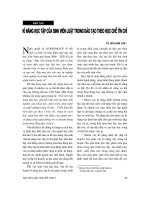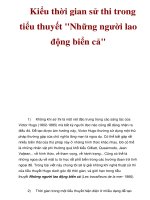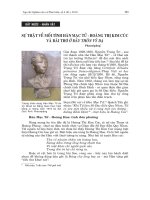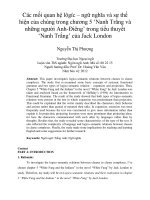MELALEUCA FOREST HABITAT IN TRA SU MELALEUCA FOREST LANDSCAPE CONSERVATION AREA, TINH BIEN DISTRICT,AN GIANG PROVINCE TRAN THI KIM HON và NHỮNG NGƯỜI KHÁC, tạp CHÍ đại học THỦ dầu một, số 1(40),2019,TR 60 69
Bạn đang xem bản rút gọn của tài liệu. Xem và tải ngay bản đầy đủ của tài liệu tại đây (1.09 MB, 10 trang )
Trần Thị Kim Hồng...
Melaleuca forest habitat in tra su melaleuca forest...
MELALEUCA FOREST HABITAT IN TRA SU MELALEUCA
FOREST LANDSCAPE CONSERVATION AREA,
TINH BIEN DISTRICT, AN GIANG PROVINCE
Tran Thi Kim Hong1, Nguyen Cong Thanh1, Nguyen Phu Hoa2, Banh Thanh Hung2,
Nguyen Thanh Quang3, Nguyen Xuan Du4, Nguyen Vo Chau Ngan1
1
Can Tho University, 2Forest Protection Department, An Giang Province
3
Thu Dau Mot University, 4Sai Gon University
ARTICLE INFO
Article history:
Received Oct. 9.2018, Accepted Dec. 28.2018.
Contact:
Abstract
Tra Su Melaleuca forest conservation area is one of typical flooded forests in the Mekong Delta
of Vietnam. Located at the upstream part of Mekong Delta, Tra Su Melaleuca forest is home to many
species of animals and plants under the Special Use Forest Management System of Vietnam. The
diversity and abundance of natural resources make Tra Su cajeput forests become an ideal
destination for researchers and enthusiasts to discover the wild nature. Study and understanding on
Melaleuca habitat could help conserve the Tra Su forest in sustainable way.
Keywords: Melaleuca plant, Tra Su Melaleuca forest conservation area
INTRODUCTION
Tra Su Melaleuca forest is located in Van Giao commune, Tinh Bien district, An Giang
province with an area of 845 ha, which is one of the existing natural and semi-natural habitats in the
Mekong Delta (An Giang’s Forest Protection Department, 2004). Tra Su Melaleuca forest has a
significant environmental significance such as regulating climate, maintaining soil stability and
fertility, limiting floods, droughts, preserving water sources and habitats for many species of plants
and animals (Le Quoc Tuan et al.). Especially in the situation of abnormal climate change, there are
increasingly negative impacts on the Mekong Delta, the role of forests becomes more and more
important. There is a correlation between Melaleuca and other plant communities, but they can both
support each other and affect each other. For example, more reeds, ferns will grow, they will form a
dense community, put a pressure on the growth and development of Melaleuca and will take away
the habitat of birds, bees, etc... (Lam Binh Loi, Nguyan Van Thon, 1972). This study is carried out
to assess the status of habitat types at Tra Su Melaleuca forest landscape conservation area, Tinh
Bien District, An Giang Province; thus providing better forest management solutions, contributing
to the sustainable development of this landscape conservation area.
60
Thu Dau Mot University Journal of Science
Issue 1(40)-2019
STUDY METHOD
The study is conducted at Tra Su Melaleuca forest landscape conservation area, Tinh Bien
District, An Giang Province from August 2016 to December 2016.
Secondary data collection
The data is based on the analysis and synthesis of relevant sources of material, data and
information (existing maps such as maps of land use status and other material and data).
Collecting basic information, material and data that have been researched related to the topic
and study area at Tra Su Melaleuca forest landscape conservation area, website, etc.
Field survey method
Based on the current land use status map of Tra Su Melaleuca forest landscape conservation
area, 20 sample cells of 10,000 m2 (100 m × 100 m) are set up for the survey.
In each sample cell, 1 central cell of 100 m2 (10 m × 10 m) and 2 random cells of the same
size so that the distance between cells ≥ 30 m and the distance between cells with the edges of the
standard cell ≥ 20 m (Le Minh Loc, 2005).
The survey locations are shown in Figure 1.
Figure 1. Survey location map of Tra Su
Melaleuca forest
Note: -
Dike
Standard
cell
- Main
channel
- Ecologic
al
restoration
zoning
- Zone of
strict
protection
- Administ
rative
Services
Zoning
Figure 2. Surveyed cell in the standard cell
Standard cell 1000m2
Survey cell 100m2
Table 1. Coordinates of surveyed standard cells
Zone
Ecological
restoration zoning
Survey location
ST257
ST126
ST157
ST164
X
505832.309
505326.541
504978.921
506511.891
61
Y
1170784.126
1170782.770
1170505.873
1170923.927
Habitat
Melaleuca Cajuputi
Melaleuca Cajuputi
Melaleuca Cajuputi
Melaleuca Cajuputi
Trần Thị Kim Hồng...
Zone of
protection
strict
Administrative
Services Zoning
Melaleuca forest habitat in tra su melaleuca forest...
ST57
ST36
NN57
NN205
NN239
NN68
NN157
NN104
NN221
NN25
NN84
NN256
NN286
NN384
NN319
506624.613
507236.408
504963.300
505356.369
505862.140
506031.214
506286.475
506731.167
506909.711
507252.576
507584.543
507512.565
507747.452
507598.741
506801.595
1171357.882
1171280.263
1170091.887
1169659.271
1169660.621
1170311.577
1170055.994
1170352.862
1169978.857
1170768.200
1170631.111
1170000.133
1169843.060
1169093.611
1169032.382
Melaleuca Cajuputi
Eleocharis
Melaleuca Cajuputi
Melaleuca Cajuputi
Melaleuca Cajuputi
Melaleuca Cajuputi
Melaleuca Cajuputi
Melaleuca Cajuputi
Melaleuca Cajuputi
Melaleuca Cajuputi
Melaleuca Cajuputi
Melaleuca Cajuputi
Melaleuca Cajuputi
Melaleuca Cajuputi
Melaleuca Cajuputi
HC01
505283.958
1168935.026
Lotus
In each cell of 100 m2, the following criteria are studied:
- Counting all Melaleuca in each cell, symbol n (tree)
- Using tape measure to measure the diameter of the stem at a distance of 1.3 m from the
ground, symbol D1-3 (Pham Xuan Quy, 2008)
- Measuring the height of tree
- Recognizing variety composition of vegetation, shrubs, exotic plants, tree tier (if there are
plants other than Melaleuca).
Data processing method
Formulas of calculation based on Le Minh Loc (2005):
Density (trees/ha) = (n/S) × 1000
in which
n: total number of trees
2
S: cell area (m )
Horizontal cross-section: G = 3.14×d2/4
in which G: the cross-section area at a height of 1.3 m from the ground (m2)
d: tree diameter (m)
Microsoft Excel is used to present collected data.
RESULTS AND DISCUSSIONS
Growth criteria of Melaleuca
Total area of Tra Su Melaleuca forest landscape conservation area is 845 hectares. Data is
collected in 20 cells (10.000 m2) and Melaleuca is divided into 5 age groups: group I (10 - 15
years), group II (16 - 20 years), group III (21 - 25 years), group IV (26 - 30 years), and group V
(over 30 years).
62
Thu Dau Mot University Journal of Science
Issue 1(40)-2019
Survey results of Melaleuca growth criteria of diameter at breast height, high top and density
of the cells are shown in Table 2.
Table 2. Criteria of Melaleuca in Tra Su
No
Age group
1
2
3
4
5
6
7
8
9
10
11
12
13
14
15
16
17
18
19
20
Group I
(10 years)
15
Group II
(16 years)
20
Group III
(21 - 25
years)
Group IV
(26 - 30
years)
Group V
(> 30 years)
Sample
cell
NN57
NN205
ST126
NN319
NN157
NN239
ST157
NN221
NN104
NN25
NN384
NN286
HC01
NN68
NN256
ST57
ST36
NN84
ST257
ST164
Melaleuca
age
10
11
12
12
17
17
18
20
20
20
21
21
23
26
26
28
28
32
33
33
Density
(tree/100 m2)
49
82
36
29
25
39
43
29
60
109
47
37
6
62
36
76
8
59
66
50
Average
diameter (cm)
18,10
15,50
17,73
19,85
21,19
19,85
19,43
18,67
15,80
14,27
17,09
18,26
21,44
17,33
18,05
16,60
19,00
17,31
17,20
19,17
Average
height (m)
20,13
14,93
13,29
23,68
10,27
14,60
25,66
17,48
16,04
13,27
20,43
10,94
20,99
9,27
10,50
15,48
17,19
15,77
16,98
16,25
Melaleuca age
Melaleuca at Tra Su Melaleuca forest landscape conservation area are 10 years or more.
Based on the age of Melaleuca, there are five age groups of survey:
- Group I: 10 - 15 age (NN57, NN205, ST126, NN319)
- Group II: 16 - 20 age (NN157, NN239, ST157, NN221, NN104, NN25)
- Group III: 21 - 25 age (NN384, NN286, HC01, NN68, NN256)
- Group IV: 26 - 30 age (ST57, ST36, NN84, ST257, ST164)
- Group V: > 30 age (NN84, ST257, ST164)
Melaleuca at Tra Su Melaleuca forest landscape conservation area are at high age with an
average age of 20, the highest one is 33 years (grown in 1983) and the lowest one is 9 years (grown
in 2007). In the last 12 years, green area of Melaleuca are relatively low, concentrated in cells
ST126 (1a), NN205 and NN57 (lot 2a), NN319 (lot 6a) and on Eleocharis habitat in lot 4b.
Melaleuca trees are from 16 - 20 and 21 - 25 years covering the largest area and distributed in
cells NN157, NN239, ST157, NN221, NN104, NN25, NN384, NN286, HC01. Melaleuca trees are
planted here are quite thick, especially cell HC01 belongs to lotus habitat so the density is quite thin.
Melaleuca forests are from 26 - 30 and over 30 years covering small area are distributed in
cells NN68, NN256, ST57, ST36, NN84, ST257, ST164. This is the area of Melaleuca grown from
1983 - 1984 (cells NN84, ST257, ST164). According to observation, the Melaleuca have quite large
fall phenomenon.
63
Trần Thị Kim Hồng...
Melaleuca forest habitat in tra su melaleuca forest...
10 - 15 years
16 - 20 years
21 - 25
years
26 - 30
years
> 30 years
Figure 3. Melaleuca age in sample cells
Melaleuca density
Forest tree density is calculated by counting all alive trees in each survey cell (100 m 2), then
calculating unit of tree per hectare. The average density of Melaleuca in age group is shown in
Figure 4.
10 - 15 years
16 - 20 years
21 - 25 years
26 - 30 years
> 30 years
Figure 4. Melaleuca density in age group
Trees in Tra Su Melaleuca forest of all age groups are very dense. Age group III (21 - 25
years) is experienced the lowest density (3,000 trees/ha) and age group V (over 30 years) is
experienced the highest density (5,833 trees/ha). The reason is that in cell HC01 of Group III is
lotus habitat, so Melaleuca density is very low (average 6 trees/100 m2). Cell NN25 (group II) is
experienced the highest average density of 109 trees/100 m2.
The density of Melaleuca is not only affected by Melaleuca life-time but also depends on
many factors such as flooding, shrubs and vines and the impact of forest fires during the growth and
development. Forest fire on August 30th, 2015 destroyed 20ha of forest at lot 4b, thus greatly
affecting the density and number of Melaleuca trees here (cell ST36).
64
Thu Dau Mot University Journal of Science
Issue 1(40)-2019
According to the Designing Normative on Forest Business (1984), if the forest density is less
than 1,000 trees/ha, it is considered as sparse; if the density is between 1,000 and 2,000 trees /ha,
the density is considered as averaged; if the density is 2,000 trees/ha, it is considered as thick. With
data above, the Melaleuca forest at Tra Su Melaleuca forest landscape conservation area is very
thick thanks to Melaleuca plantation.
Melaleuca height
Melaleuca height is measured by a height meter with a precision of 0.1m and the measuring
results by age group show that the height is not proportional to Melaleuca age. The highest average
height is age group I (18.01m) and the lowest height is group IV (13.11m). Cell NN68 (group IV) is
experienced the lowest height in 20 standard cells (9.27m), because cell NN68 (lot 2b) is an old yard of
birds, so the density here is very thick (62 trees/100 m2) the height at this cell is not well developed.
10 - 15 years
16 - 20 years
21 - 25 years
26 - 30 years
> 30 years
Figure 5. Average height of Melaleuca in age group
In group I, Melaleuca in cells NN57 and NN319 are superior to the age, with average height
of 20.13m and 23.68m respectively. These forests are planted by row sowing and thinning up to 4
times, Melaleuca in this zone are growing very well. For NN57, in 2007, Australian Melaleuca were
piloted in the plantation which brought business benefits by giving high yields and shortening the
planting time. Up to now, Melaleuca has surpassed the surrounding areas. In ST157, NN384 cells,
Melaleuca tend to grow in height to compete for light. In cell ST36 of Eleocharis habitat, with a
large area of empty land and surrounded by Eleocharis, Melaleuca here are not high to compete the
light but tend to grow in diameter.
Diameter at breast height
Average diameter at breast height in the age group of Tra Su Melaleuca forest is proportional
to the tree age for age groups I, II and III. Melaleuca under 25 years are able to grow rapidly in stem
diameter. The other 2 age groups (more than 26 years) with limited developed diameter due to:
- Below the organic layer of Eleocharis habitat cell ST36 (lot 4b) is sandy clay layer; cells
ST164, ST57 (lot 4a) appears jarosite and cells NNR84 and NN256 (lot 5b) as heavy clay so when
the older the trees grow and the roots develop to this layer, the development of Melaleuca will be
significantly affected (Truong Thi Nga et al., 2009).
65
Trần Thị Kim Hồng...
Melaleuca forest habitat in tra su melaleuca forest...
- Density of dead trees in cells NN157 and ST164 is quite high, dead density in cells NN157
is 7,033 trees/ha and in cell ST164 is 12,100 trees/ha.
10 - 15 years
> 30 years
16 - 20 years
21 - 25 years
26 - 30 years
Figure 6. Melaleuca diameter in age group
Status of habitat of Tra Su Melaleuca forest landscape conservation area
Melaleuca forest at Tra Su Melaleuca forest landscape conservation area are stratified by
height. The layers are closely related to each other including the composition of trees, the composition
of shrubs under Melaleuca canopy, the composition of fresh vegetation and exotic vegetation.
However, the habitat of Melaleuca forests, lotus and Eleocharis is very flooded in rainy season (> 1
meter flood), but drought occurs in dry season and forest fire warning at level 5. Therefore, there are
only some plants existing in Melaleuca habitat and the diversity of this habitat is not high.
Composition of trees
The composition of timber in Tra Su Melaleuca forest is mainly Melaleuca cajuputi with
relatively thick density (4,673 trees/ha) and many different ages. In addition to Melaleuca, there are also
Acacia mangium, Eucalyptus alba, Acaciaauriculaeformis, etc. They grow mainly on the forest edges.
Figure 7. Compositions of timber
66
Thu Dau Mot University Journal of Science
Issue 1(40)-2019
Compositions of shrubs under Melaleuca canopy
The compositions of main shrubs are found in the forest edge habitat. In addition, some
varieties are found in forest habitat and lotus habitats such as Sesbania sesban, Mimosa pigra,
Phragmites australis, etc. They grow right under the forest canopy with low and scattered densities,
growing in small clusters.
The composition of shrubs contributes to the diversity of habitat in the forest, which is home
to many species of animals and insects such as ants, birds, worms, etc. However, the strong
development of shrubs also leads to bad influences, causing loss of paths in the forest canopy.
Thriving shrubs will use more organic matters in the soil, affecting the growth and development of
Melaleuca forest.
Composition of fresh vegetation
Fresh vegetation in the forest includes herbaceous plants (without wood structure), mainly
distributed in forest edge habitats. In addition, some plants are found in:
- Forest habitat and lotus habitat: Brachiara mutica, Eclipta prostrata, Cyclosorus
parasiticus, Glinus oppositifolius.
- Melaleuca forest habitat: Scoparia dulcis, Ceratopteris thalictroides, Axonopus compressus,
Struchium sparganophorum, Ageratum conyzoides, Alternanthera sessilis, Ludwigia adscendens,
Heliotropium indicum.
- Lotus habitat: Acalypha brachystachya, Panicum repens, Commelina paludaso, Euphorbia
atoto, Cyperus digitatus
- Eleocharis habitat: Eleocharis dulcis
Figure 8. Some plants of fresh vegetation
The role of fresh vegetation as well as shrubs, many plants bring highly economic benefits.
From an ecological point of view, layers of shrubs and fresh vegetation are important, and they
contribute to soil protection, erosion prevention, soil moisture retention, and soil formation and
improvement. However, they may also be obstacles to regeneration, which causes difficulties in
reforestation and rehabilitation.
Exotic plants
The major exotic plants are vines found in the forest edge habitat. In addition, some plants are
found in:
67
Trần Thị Kim Hồng...
Melaleuca forest habitat in tra su melaleuca forest...
- Forest landscape habitat and lotus habitat: Lygodium japonicum, Pueraria phaseoloides,
Stenochiaena palustris, Zehneria indica, Passiflora foetida, Ipomoea aqiuatica.
- Melaleuca forest habitat: Lygodium japonicum, Cayratia trifolia.
Figure 9. Exotic plants
Vine plants contribute to the increase in biodiversity in the forest, and they are also home to
insects such as ants, insects, etc. Excessive exotic vegetation affects the growth and development
process of Melaleuca forest: their supporters are Melaleuca stems. The vines living on to
Melaleuca’s stem will damage the Melaleuca, they absorb nutrients from the Melaleuca and make
them develop slowly, etc.
In addition, in the lotus habitat and some Melaleuca of permanent flood, such as ST164 (slot
4a), there is also the presence of aquatic plants such as Lemnoideae, Pistia stratiotes.
CONCLUSION AND RECOMMENDATION
Conclusion
Melaleuca is in Tra Su Melaleuca forest conservation area is quite large, mainly over 20
years, the density of Melaleuca is very thick to very thick: from 3,000 trees/ha with Melaleuca in
age group from 21 to 25 years to age group from 26 - 30 years, 10 - 15 years and 16 - 20 years are
4,550 trees/ha, 4,900 trees/ha and 5,083 trees/ha, respectively, with the highest number of trees in
the age group of 30 years with 5,833 trees/ha.
The average height is lowest in the 26 - 30 age group with the height of 13.11 m, the highest
average height group is the age group 10 - 15 years with the height of 18.01 m.
The highest average diameter in the 21 - 25 age group is 18.93 cm and the lowest is the 26 30 age group at 17.75 cm.
The criteria of height, diameter at chest height, the density show that the growth and
development of Melaleuca in Tra Su forest depend not only entirely on the age of Melaleuca forest
68
Thu Dau Mot University Journal of Science
Issue 1(40)-2019
but also depends on factors such as flooding, soil, shrubs and vines, etc Degraded forest area is the
survey cells NN25, NN239 and ST164 respectively of cells 5b, 2b, 4a. It should be planted in
degraded and dead areas.
Melaleuca forest is stratified at the height, including the composition of timber, the
composition of shrubs under Melaleuca canopy, the composition of fresh vegetation and exotic
plants, but the effect is negligible.
Recommendation
Further research on (fresh and dry) biomass and carbon reserves of Melaleuca forest,
subterranean elements and organic layer of Melaleuca should be continued to be done.
It is necessary to consider and study solutions to overcome the overcrowding of Melaleuca
forest, to grow trees on bare land and in dead Melaleuca forest.
REFERENCES
An Giang’s Forest Protection Department (2004). Luận chứng khoa học thành lập Khu Bảo vệ cảnh
quan Trà Sư, tỉnh An Giang.
Lâm Bỉnh Lợi, Nguyễn Văn Thôn (1972). Rừng ngập nước Việt Nam. Bộ Nông nghiệp và Ngư
nghiệp Sài Gòn.
Lê Minh Lộc (2005). Phương pháp đánh giá nhanh sinh khối và ảnh hưởng của độ sâu ngập lên
sinh khối rừng Tràm (Melaleuca cajuputi) trên nền đất than bùn và đất phèn khu vực U Minh
Hạ tỉnh Cà Mau (Luận văn Thạc sĩ). Đại học Can Tho.
Lê Quốc Tuấn, Nguyễn Thị Hà Vy, Bùi Xuân An (xxxx). Nghiên cứu và định hướng phát triển du
lịch sinh thái rừng tràm Trà Sư, tỉnh An Giang. Retrieved />data/quoctuan/Bai%20bao%203%20_Khoa%20MT-TN_.pdf, dated Dec 23rd 2017.
Ministry of Forest (1984). Quy phạm thiết kế kinh doanh rừng . Quyết định 682/QĐKT.
Phạm Xuân Quý (2008). Xây dựng mô hình dự đoán sinh khối rừng tràm (Melaleuca cajuputi) ở
khu vực Tây Nam Bộ. Retrieved
/>download&gid=453&Itemid=498&lang=v, dated Dec 23rd 2017.
Trương Thị Nga, Đinh Hoài Ửng, Nguyễn Công Thuận (2009). Hiện trạng đất khu bảo vệ cảnh
quan rừng tràm Trà Sư - tỉnh An Giang. Can Tho University Journal of Science (12), 9–14.
69









